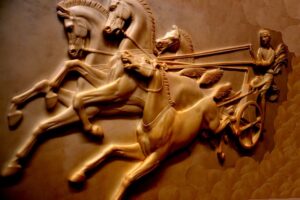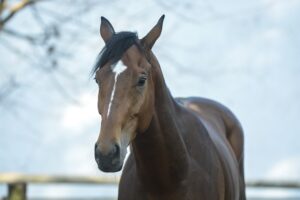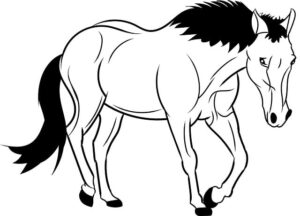The Grand National has a rich history detailing famous stories about horses, trainers, owners and jockeys. I’m sure you have your favourites. While the great and good in horse racing have ambitions of winning the most famous race in the world very few achieve this feat. While many horse owners have tasted success there are a few connections who have made it there business to be a serious candidate.
Gigginstown House Stud: A Force in National Hunt Racing
One such owner is Gigginstown House Stud. The familiar burgundy and white silks (white star of chest and hat, white armbands) are linked with Ryanair CEO Micheal O’Leary, who is no stranger to the Aintree Grand National. Based in County Westmeath, Ireland, this set up have been prominent in National Hunt racing for two decades.
In fact, he sponsored many races including the Ryanair Chase since 2005 and took Grade 1 status in 2008. O’Leary has used his wealth with a number of exceptional racehorses and predominantly Irish horse trainers including Gordon Elliott and formerly Willie Mullins which ended in 2016. While other prominent names include who have shared success include Henry de Bromhead, Noel Meade, Joseph O’Brien & Mouse Morris.
Exceptional Trainers and Horses
Michael O’Leary has invested heavily in his racing operation, working with many of the finest trainers in Ireland and the UK. Among the trainers who have brought success to Gigginstown are:
-
Gordon Elliott: Gigginstown’s primary trainer in recent years, responsible for horses like Tiger Roll and Don Cossack.
-
Willie Mullins: Formerly a key trainer for Gigginstown, though their partnership ended in 2016 over a disagreement about fees.
-
Henry de Bromhead: Trainer of Balko des Flos, among others.
-
Noel Meade: Notable for his work with horses like Road To Riches.
-
Joseph O’Brien: A rising star who has trained several winners for Gigginstown.
-
Mouse Morris: Trainer of Rule The World, a Grand National champion.
Major Wins by Gigginstown Horses
Cheltenham Festival
-
Don Cossack (Cheltenham Gold Cup, 2016; trained by Gordon Elliott)
-
Balko des Flos (Ryanair Chase, 2018; trained by Henry de Bromhead)
-
Apple’s Jade (Multiple wins in mares’ races; trained by Gordon Elliott)
Irish Gold Cup
Aintree Grand National Success
The Grand National is what jump racing is all about. Gigginstown House Stud has tasted victory twice with two exceptional horses, resulting in three memorable wins:
Rule The World (2016)
-
Trainer: Mouse Morris
-
Jockey: David Mullins
-
Rule The World, won the Aintree Grand National in 2016. Trained by Mouse Morris, ridden by David Mullins. The nine-year-old gelding proved something of a shock win at odds of 33/1 for Gigginstown House Stud. On soft ground, this gelding won by six lengths beating 38 rivals taking a £561,300. He raced once more at Punchestown in the Growise Champion Novice Chase (Grade 1) before retiring.
Tiger Roll (2018, 2019)
-
Trainer: Gordon Elliott
-
Jockey: Davy Russell
2018 – Tiger Roll’s First Win
Tiger Roll, a 10/1 shot, won the 171st Grand National in a thrilling finish, holding off Pleasant Company by a head. The victory earned Gigginstown £500,000 and established Tiger Roll as a fan favorite.
2019 – Back-to-Back Glory
Tiger Roll made history being one of only four horses to win consecutive race in this famous steeple chase. Others included: The Duke (1836, 1837), won the first two Grand Nationals for trainer/jockey Captain Martin William Becher, in the ownership of Mr Sirdefield. Abd-El-Kadir (1850, 1851), trained by Joseph Osborne. Not forgetting Grand National hero Red Rum, trained by Ginger McCain who achieved a trio of victories in 1973, 1974 & 1977. He finished runner-up twice.
Tiger Roll won his second Grand National under a weight of 11-5lb, ridden by Davy Russell, beating Magic Of Light, trained by Mrs John Harrington, by two-and-three-quarter lengths. The 4/1f beat 39 rival to win £500,000. Many compared Tiger Roll with Red Rum. In fact, he was fancied to challenged Ginger McCain’s hero for three consecutive wins. Unfortunately, the 2020 Aintree Grand National was cancelled due to the outbreak of the Covid 19 pandemic.
Retirement
Tiger Roll never had another opportunity to race in the Aintree Grand National. He was retired on the 16th March 2022 after finishing a gallant runner-up to his stable mate Delta Work at Cheltenham in the Glenfarclas Chase (Cross Country Chase) over 3m 6f (a race he had won three times: 2018, 2019 & 2021).
Legacy of Gigginstown House Stud
Gigginstown House Stud and Michael O’Leary have become a household name within National Hunt racing. He has achieved exceptional wins including Grand National victories with Rule The World & the brave Tiger Roll.
 Ironically, the year in which most horses completed the Grand National course was 1984, when a safety limit of 40 runners, which has remained in place ever since, was imposed for the first time. On March 31, 1984, on good going, the well-backed ten-year-old Hallo Dandy, trained by Gordon W. Richards and ridden by Neale Doughty, led home a total of 23 finishers, thereby setting a record which has yet to be beaten. In so doing, Hallo Dandy, who had finished fourth behind Corbiere, Greasepaint and Yer Man in the 1983 renewal of the Grand National, reversed the previous form with that trio, who finished third, second and seventeenth, respectively.
Ironically, the year in which most horses completed the Grand National course was 1984, when a safety limit of 40 runners, which has remained in place ever since, was imposed for the first time. On March 31, 1984, on good going, the well-backed ten-year-old Hallo Dandy, trained by Gordon W. Richards and ridden by Neale Doughty, led home a total of 23 finishers, thereby setting a record which has yet to be beaten. In so doing, Hallo Dandy, who had finished fourth behind Corbiere, Greasepaint and Yer Man in the 1983 renewal of the Grand National, reversed the previous form with that trio, who finished third, second and seventeenth, respectively. Most horse racing fans remember Red Rum. A name synonymous with the most famous steeplechase in the world: The Grand National. In fact, its history dates back to 1839. The race is held annually at Aintree Racecourse, Liverpool. This handicap steeplechase covers a distance of 4 miles 2 ½ furlongs. Two laps are run, 30 jumps, many with famous stories behind them including the infamous Chair.
Most horse racing fans remember Red Rum. A name synonymous with the most famous steeplechase in the world: The Grand National. In fact, its history dates back to 1839. The race is held annually at Aintree Racecourse, Liverpool. This handicap steeplechase covers a distance of 4 miles 2 ½ furlongs. Two laps are run, 30 jumps, many with famous stories behind them including the infamous Chair. The term ‘steeplechase’ was first recorded in the late eighteenth century and was derived from the fact that participants kept a course, over open countryside and natural obstacles, by sighting a church steeple as a finishing point. Nowadays, the term refers to a horse race run on a turf course furnished with fabricated obstacles – albeit that they are constructed, in part, with natural materials – which horses must negotiate.
The term ‘steeplechase’ was first recorded in the late eighteenth century and was derived from the fact that participants kept a course, over open countryside and natural obstacles, by sighting a church steeple as a finishing point. Nowadays, the term refers to a horse race run on a turf course furnished with fabricated obstacles – albeit that they are constructed, in part, with natural materials – which horses must negotiate. The first post-war Grand National was staged at Aintree on April 5, 1946 and, notwithstanding the cancellation of the Grand National Festival in 2020, due to the global COVID-19 pandemic, the celebrated steeplechase has been run over more or less the same course and distance ever since. Of course, in 1993 the Grand National was officially declared void after the majority of the jockeys failed to realise a second false start had been called and seven, led by the hapless John White on Esha Ness, completed the course.
The first post-war Grand National was staged at Aintree on April 5, 1946 and, notwithstanding the cancellation of the Grand National Festival in 2020, due to the global COVID-19 pandemic, the celebrated steeplechase has been run over more or less the same course and distance ever since. Of course, in 1993 the Grand National was officially declared void after the majority of the jockeys failed to realise a second false start had been called and seven, led by the hapless John White on Esha Ness, completed the course.